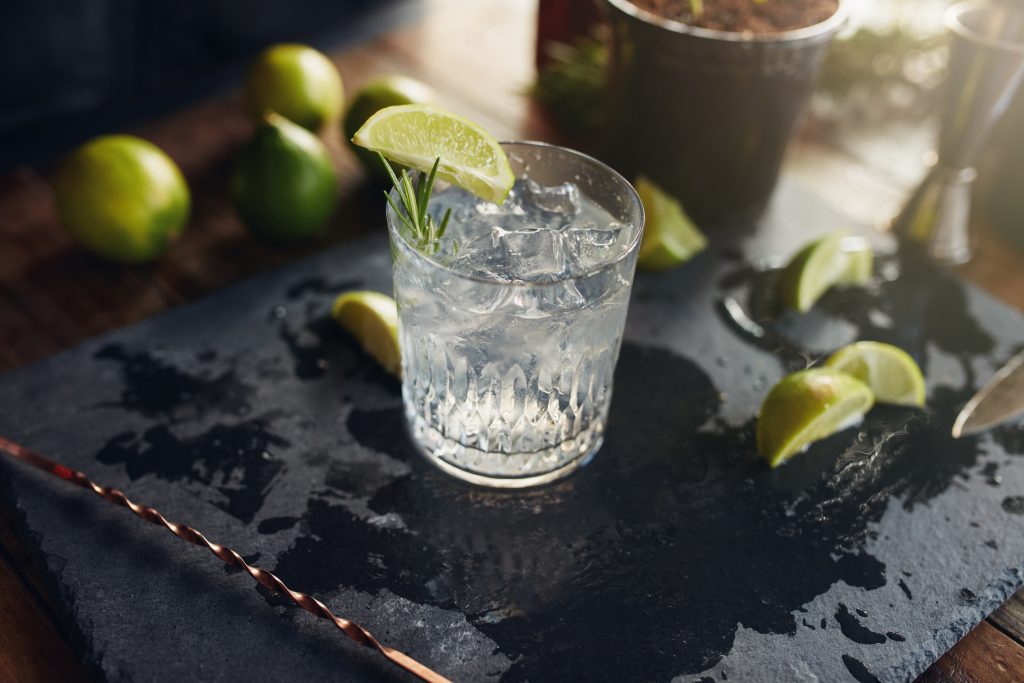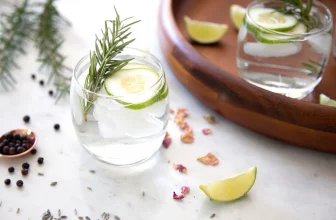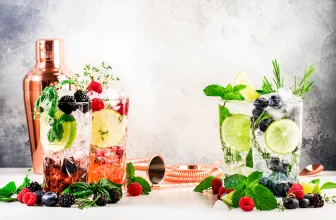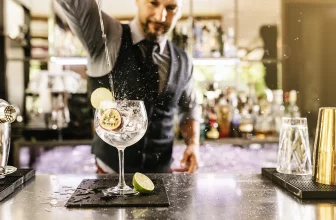What is Gin? Few spirits are as divisive as gin. Not bourbon, rye, or even scotch. But love it or hate it, gin is a staple of cocktail culture, and neither amateur nor professional mixologists can afford to ignore it. To learn a bit more about gin — how it’s made, what the various types are, and where it came from — read on! Consider this your first lesson in Gin School.

About Gin
Unlike most liquors that are defined by their production process, gin is defined by its flavor profile. No matter how it’s made, the predominant flavor is usually juniper!, which gives it that signature piney aroma. That’s what some people love — and some find so off-putting. To be clear some people hate juniper. Hence why our positive and negative recommendations for gin is dripping with juniper.
If you’re one of those “I don’t like gin” people, you should experiment with a few different brands. Some taste much less like a Christmas Tree and more like a fresh garden. The botanicals shine in slightly sweet, fruity cocktails.
Gin Pairings
Music
Food
Cannabis Strains
Frequently Asked Questions About Gin
How is Gin Made?
Most gins actually start just like vodka — with a neutral spirit distilled from an agricultural product like potatoes, grapes, barley, wheat, or just plain sugarcane. A neutral spirit is an unflavored alcoholic base that can be used to create vodka, gin, bitters, and some liqueurs.
After the fermentation and distillation, that neutral spirit is redistilled with a blend of botanicals to make gin. The only flavor that has to be present — as mentioned earlier — is juniper. If the predominant flavor isn’t juniper, then it isn’t gin.
Each gin producer has its own proprietary botanical blend. Common flavors include citrus, nutmeg, cinnamon, coriander, anise, fennel, and almond.
What are the styles of Gin?
There are four traditional styles of gin, although some new brands are pushing the envelope and making products that don’t fit into any of these categories!
London Dry Gin
This is the most common gin, made as described above, with a neutral spirit and redistilled with juniper. (It doesn’t have to be from London!)
Dutch Genever
Dutch Genever is the original gin. In fact, the word “genever” is Dutch for juniper. This version starts with malted grain mash, like whiskey. It can also be barrel-aged, adding depth and nuance to the spirit.
Genever is much less common than London Dry, but there are still companies producing it today, like Bols in Amsterdam and de Borgen in the Netherlands.
Old Tom
Old Tom is usually made by adding sugar during the redistillation process. It’s a bit sweeter than London Dry, and a bit drier than Dutch Genever. It also often has a lighter botanical flavor than London Dry.
Old Tom had fallen out of favor in the 20th century. But now that people are wild for the good ol’ days of cocktails, it’s popping up again from distilleries like Ransom and Queen’s Courage.
Compound Gin
In compound gin, flavor essences are added to the spirit without redistillation, more like an infusion. Although this was the method used in Prohibition’s “bathtub gin,” that doesn’t mean compound gin is no good.
Popular Hendricks Gin is made with this method because its delicate cucumber and rose flavors would be destroyed in the redistillation process. So the producers add those fragile ingredients after distilling the gin with juniper.

Here are a few classic cocktails made with gin.
- Gin and Tonic
- Tom Collins
- French 75
- Gin Gimlet
- Classic Negroni
The Roaring History of Gin
While many of us associate gin with Prohibition and the Roaring ’20s, gin wasn’t always the classy cocktail base that we know today.
Gin is old. Real old.
The Roaring History of Gin
While many of us associate gin with Prohibition and the Roaring ’20s, gin wasn’t always the classy cocktail base that we know today.
Gin is old. Real old.
1200-1300
A Flemish manuscript from the 13th century refers to a liquor flavored with genever.
1500-1600
And in the 1600s, records show hundreds of gin distilleries in operation in Amsterdam. While it was originally consumed as medicine, it didn’t take long for people to use it for more than their health.
1700-1800
By the early 18th century, gin had taken hold of England, helped along by tax breaks on distilled spirits.
With gin being so cheap and abundant, the English “Gin Craze” began. It was the drink of rich and poor alike — but the poor man’s gin was regularly adulterated with additives like turpentine and sulfuric acid.
Realizing that half the populace was drunk on gin and the other half was being poisoned by it, Parliament began passing legislation to raise taxes and licensing standards for gin producers.
1830
By the 1830s, things were improving for gin. Improvements in column stills made a cleaner spirit. And the British Navy’s love of gin and need for malaria-fighting quinine led to the popularity of the Gin and Tonic. (Quinine is the predominant flavor in tonic water.)
Unsurprisingly, the Brits brought their favorite spirit to America with them. Even after the Revolution, gin grew in popularity in the US, used in classic cocktails like the Gin Rickey, Tom Collins, and of course, the original martini.
When Prohibition hit, bootleggers began making gin at home in miniature stills in their kitchens. It was as awful as it sounds. But it led to a rash of new gin cocktails to disguise the taste.
1850
By the 1950s, vodka was the fresh new booze on the block, and it edged gin out. Even James Bond wanted vodka. So gin became the domain of the old-timers.
2017-2019
Now, we’re experiencing a gin rebirth. In the UK alone, gin sales increased by over 25% between 2017 and 2019. New distilleries are playing with their own botanical blends, toning down the juniper, and creating a cocktail-ready flavor profile.
Summary
Gin has had a wild history, veering from medicine to poison to cocktail staple to the red-headed stepchild of the mixology world.
With its juniper flavor profile, gin can be polarizing. But many modern distillers are playing with that balance, bringing out fresh and unusual botanicals while keeping its piney essence.
So next time you head out for happy hour, give a gin cocktail a try. You just might discover something special.






